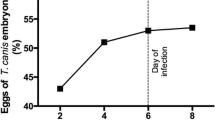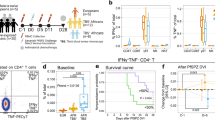Abstract
A marked variation, in terms of time lag gap of the depiction of visible clinical signs and the actual appearance of parasitic stages in body tissues, exists in experimental toxoplasmosis. Keeping this in mind, a study was designed to find out the time gap associated variability in appearance of tachyzoites in blood stream of infected mice. For this purpose, surface antigen 3 (SAG 3) was selected as a candidate to detect toxoplasmosis from blood samples taken at regular intervals from murine models. PCR was standardized to diagnose toxoplasmosis in ten inbred Swiss albino mice after experimental inoculation of 100 tachyzoites of laboratory maintained human RH strain of the parasite. The blood samples were subjected to PCR, in duplicates, using primers directed to the multicopy of SAG 3 gene at regular 12 -h interval post infection. The tachyzoites begin to appear between 36 h post infection and by 48 h blood of all the mice were found to be infected by tachyzoites. Alongside, other visible symptoms begin to appear after 72 h post infection. In conclusion, ample time gap was found regarding the initiation of clinical infection and actual appearance of visible clinical signs that could prove detrimental in final outcome of condition.

Similar content being viewed by others
References
Angel SO, Matrajt M, Margarit J et al (1997) Screening of active Toxoplasma in patients by DNA hybridization with ABGTg7 probe in blood samples. J Clin Microbiol 35:591–595
Brenier-Pinchart MP, Blanc-Gonnet E, Marche PN et al (2004) Infection of human astrocytes and glioblastoma cells with Toxoplasma gondii: monocyte chemotactic protein-1 secretion and Chemokine expression in vitro. Acta Neuropathol 107:245–249
Fekadu A, Shibre T, Cleare AJ (2010) Toxoplasmosis as a cause for behavior disorders—overview of evidence and mechanisms. Folia Parasitol 57:105–113
Homan WL, Vercammen M, De Braekeleer J (2000) Identification of a 200- to 300-fold repetitive 529 bp DNA fragment in Toxoplasma gondii, and its use for diagnostic and quantitative PCR. Int J Parasitol 30:69–75
Hurtado A, Aduriz G, Moreno B et al (2001) Single tube nested PCR for the detection of Toxoplasma gondii in fetal tissues from naturally aborted ewes. Vet Parasitol 102:17–27
Jacquet A, Coulon L, Neve JD et al (2001) The surface antigen SAG3 mediates the attachment of Toxoplasma gondii to cell-surface proteoglycans. Mol Biochem Parasitol 116:35–44
Kazemi B, Maghen L, Bandehpour M et al (2007) Gene cloning of P43 surface protein of Toxoplasma gondii tachyzoite and bradyzoite (SAG3). Gene Ther Mol Biol 11:113–116
Luft BJ, Remington JS (1992) Toxoplasmic encephalitis in AIDS. Clin Infect Dis 15:211–222
Montoya JG, Liesenfeld O (2004) Toxoplasmosis. Lancet 363:1965–1976
Parker GA, Langloss JM, Dubey JP et al (1981) Pathogenesis of acute toxoplasmosis in specific-pathogen-free cats. Vet Pathol 18:786–803
Skariah S, McIntyre MK, Mordue DG (2010) Toxoplasma gondii: determinants of tachyzoite to bradyzoite conversion. Parasitol Res 107:253–260
Sreekumar C, Rao JR, Mishra AK et al (2004) Detection of toxoplasmosis in experimentally infected goats by PCR. Vet Rec 15:632–635
Sudan V, Tewari AK, Singh H et al (2012) Molecular characterization of surface antigen 3 (SAG3) gene of Toxoplasma gondii RH-IVRI strain. J Parasit Dis 36(2):210–214
Sudan V, Tewari AK, Singh H (2014a) An insight into the behavior, course and kinetics of acute infection of Toxoplasma gondii human RH strain in experimentally infected murine model. Iran J Parasitol 9(1):114–119
Sudan V, Tewari AK, Singh H et al (2014b) Pathobiology of human RH strain induced experimental toxoplasmosis in murine model. J Parasit Dis. doi:10.1007/s12639-014-0589-1
Tenter AM, Heckeroth AR, Weiss LM (2000) Toxoplasma gondii: from animal to humans. Int J Parasitol 30:1217–1258
Webster JP, Lamberton PHL, Donnelly CA et al (2006) Parasites as causative agents of human affective disorders? The impact of anti-psychotic, mood-stabilizer and anti-parasite medication on Toxoplasma gondii’s ability to alter host behaviour. Proc Biol Sci 273:1023–1030
Acknowledgments
The authors are thankful to the Director, IVRI for providing the facilities provided and to the ICAR for the fellowship awarded to the first author during the perusal of his masters programme.
Conflict of interest
The authors declare that they have no competing interest.
Author information
Authors and Affiliations
Corresponding author
Rights and permissions
About this article
Cite this article
Sudan, V., Tewari, A.K. & Singh, H. Post challenge variability in time gap pertaining to appearance of Toxoplasma gondii DNA in blood and appearance of visible clinical signs in murine model. Comp Clin Pathol 25, 43–46 (2016). https://doi.org/10.1007/s00580-015-2136-6
Received:
Accepted:
Published:
Issue Date:
DOI: https://doi.org/10.1007/s00580-015-2136-6




